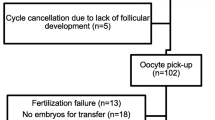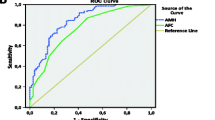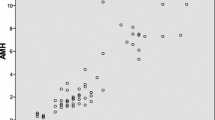Abstract
Purpose
To evaluate the predictive value of basal serum anti-müllerian hormone level and small antral follicle count for high ovarian response to controlled ovarian hyperstimulation.
Methods
A total of 159 patients were prospectively included. Basal serum anti-müllerian hormone and small antral follicle count (2–6 mm) were measured.
Results
Small antral follicle count and anti-müllerian hormone have similar predictive accuracy for high ovarian response with area under curve of 0.961 and 0.922, respectively. The sensitivity and specificity for prediction of high ovarian response were 89% and 92% for small antral follicle count and 93% and 78% for anti-müllerian hormone at the cutoff values of ≥ 16 and ≥ 34.5 pmol/l, respectively.
Conclusions
Small antral follicle count and anti-müllerian hormone are equally accurate predictors of high ovarian response and facilitate determination of the optimal strategy for controlled ovarian hyperstimulation.


Similar content being viewed by others
References
Lee MM, Donahoe PK, Hasegawa T, Silverman B, Crist GB, Best S, et al. Mullerian inhibiting substance in humans: normal levels from infancy to adulthood. J Clin Endocrinol Metab. 1996;81:571–6. doi:10.1210/jc.81.2.571.
Weenen C, Laven JS, Von Bergh AR, Cranfield M, Groome NP, Visser JA, et al. Anti-mullerian hormone expression pattern in the human ovary: potential implication for initial and cyclic follicle recruitment. Mol Hum Reprod. 2004;10:77–83. doi:10.1093/molehr/gah015.
Durlinger ALL, Gruijters MJG, Kramer P, Karles B, Kumer TR, Matzuk MM, et al. Anti-Mullerian hormone attenuates the effects of FSH on follicle development in the mouse ovary. Endocrinology. 2001;142:4891–9. doi:10.1210/en.142.11.4891.
Durlinger ALL, Gruijters MJG, Kramer P, Karles B, Ingraham HA, Nachtigal MW, et al. Anti-mullerian hormone inhibits initiation of primordial follicle growth in mouse ovary. Endocrinology. 2002;143:1076–84. doi:10.1210/en.143.3.1076.
Gruijters MJG, Visser JA, Durlinger ALL, Themmen AP. Anti-mullerian hormone and its role in ovarian function. Mol Cell Endocrinol. 2003;211:85–90. doi:10.1016/j.mce.2003.09.024.
van Rooji IA, Broekmans FJ, te Velde ER, Fauser BC, Bancsi LF, Jong FH, et al. Serum anti-mullerian hormone levels: a novel measure of ovarian reserve. Hum Reprod. 2002;17:3065–71. doi:10.1093/humrep/17.12.3065.
Hehenkamp WJ, Looman CW, Thememen AP, de Jong FH, te Velde ER, Broekmans FJ. Anti-mullerian hormone levels in the spontaneous menstrual cycle do not show substantial fluctuation. J Clin Endocrinol Metab. 2006;91:4057–63. doi:10.1210/jc.2006-0331.
La Marca A, Stabile G, Artenisio AC, Volpe A. Serum anti-mullerian hormone throughout the human menstrual cycle. Hum Reprod. 2006;21:3103–7. doi:10.1093/humrep/del291.
Tsepelidis S, Devreker F, Demeestere I, Flahaut A, Gervy C, Englert Y. Stable serum levels of anti-mullerian hormone during the menstrual cycle: a prospective study in normo-ovulatory women. Hum Reprod. 2007;22:1837–40. doi:10.1093/humrep/dem101.
La Marca A, Giulini S, Tirelli A, Bertucci E, Marsella T, Xella S, et al. Anti-mullerian hormone measurement on any day of the menstrual cycle strongly predicts ovarian response in assisted reproductive technology. Hum Reprod. 2007;22:766–71. doi:10.1093/humrep/del421.
Seifer DB, MacLaughlin DT, Christian BP, Feng B, Shelden RM. Early follicular serum mullerian-inhibiting substance levels are associated with ovarian response during assisted reproductive technology cycles. Fertil Steril. 2002;77:468–71. doi:10.1016/S0015-0282(01)03201-0.
Fanchin R, Taieb J, Mendez Lozano DH, Ducot B, Frydman R, Bouyer J. High reproducibility of serum anti-mullerian hormone measurements suggests a multi-staged follicular secretion and strengthens its role in the assessment of ovarian follicular status. Hum Reprod. 2005;20:923–7. doi:10.1093/humrep/deh688.
Fleming R, Deshpande N, Traynor I, Yates RW. Dynamics of FSH-induced follicular growth in subfertile women: a relationship with age, insulin resistance, oocyte yield and anti-mullerian hormone. Hum Reprod. 2006;21:1436–41. doi:10.1093/humrep/dei499.
Nelson SM, Yates RW, Lyall H, Jamieson M, Traynor I, Gaudoin M, et al. Anti-Mullerian hormone-based approach to controlled ovarian stimulation for assisted conception. Hum Reprod. 2009;24(4):867–75.
Kline J, Kinney A, Kelly A, Reuss ML, Levin B. Predictors of antral follicle count during the reproductive years. Hum Reprod. 2005;20:2179–89. doi:10.1093/humrep/dei048.
Frattarelli JL, Levi AJ, Miller BT, Segars JH. A prospective assessment of the predictive value of basal antral follicles in in vitro fertilization cycles. Fertil Steril. 2003;80:350–5. doi:10.1016/S0015-0282(03)00664-2.
Chang MY, Chiang CH, Hsieh TT, Soong YK, Hsu KH. Use of antral follicle count to predict the outcome of assisted reproductive technologies. Fertil Steril. 1998;69:505–10. doi:10.1016/S0015-0282(97)00557-8.
Haadsma ML, Bukman A, Groen H, Roeloffzen EMA, Groenewoud ER, Heineman MJ, et al. The number of small antral follicles (2–6 mm) determines the outcome of endocrine ovarian reserve tests in a subfertile population. Hum Reprod. 2007;22:1925–31. doi:10.1093/humrep/dem081.
Lee T, Liu C, Huang C, Wu Y, Shih Y, Ho H, et al. Serum anti-mullerian hormone and esteradiol levels as predictors of ovarian hyperstimulation syndrome in assisted reproduction technology cycles. Hum Reprod. 2008;23:160–7. doi:10.1093/humrep/dem254.
Riggs RM, Duran EH, Baker MW, Kimble TD, Hobeika E, Yin L, et al. Assessment of ovarian reserve with anti-Mullerian hormone: a comparison of the predictive value of anti-Mullerian hormone, follicle-stimulating hormone, inhibin B, and age. Am J Obstet Gynecol. 2008;199:202.e1–202e8.
Broer SL, Mol BWJ, Hendriks D, Broekmans FJM. The role of anti-mullerian hormone in prediction of outcome after IVF: comparison with the antral follicle count. Fertil Steril. 2009;91:705–14. doi:10.1016/j.fertnstert.2007.12.013.
Nardo L, Gelbaya T, Wilkinson H, Roberts S, Yates A, Pemberton P, et al. Circulating basal anti-Mullerian hormone levels as predictor of ovarian response in women undergoing ovarian stimulation for in vitro fertilization. Fertil Steril. 2008. doi:10.1016/j.fertnstert.2008.08.127.
Tomas C, Nuojua-Huttunen S, Martikainen H. Pretreatment transvaginal ultrasound examination predicts ovarian responsiveness to gonadotropins in in-vitro fertilization. Hum Reprod. 1997;12:220–3. doi:10.1093/humrep/12.2.220.
Scheffer GJ, Broekmans FJ, Dorland M, Habbema JD, Looman CW, te Velde ER. Antral follicle counts by Transvaginal ultrasonography are related to age in woman with proven natural fertility. Fertil Steril. 1999;72:854–51. doi:10.1016/S0015-0282(99)00396-9.
Ng EH, Yeung WS, Ho PC. The significance of antral follicle count in controlled ovarian stimulation and intrauterine insemination. J Assist Reprod Genet. 2000;17:323–8. doi:10.1023/A:1009453011321.
Pohl M, Hohlagschwandtner M, Obruca A, Poschalko G, Weigert M, Feichtinger W. Number and size of antral follicles as predictive factors in vitro fertilization and embryo transfer. J Assist Reprod Genet. 2000;17:315–8. doi:10.1023/A:1009448810413.
Nahum R, Shifren JL, Chang Y, Leykin L, Isaacson K, Toth TL. Antral follicle assessment as a tool for predicting outcome in IVF— is it a better predictor than age and FSH? J Assist Reprod Genet. 2001;18:151–5. doi:10.1023/A:1009424407082.
Hansen KR, Morris JL, Theyer AC, Soules MR. Reproductive aging and variability in the ovarian antral follicle count: application in the clinical setting. Fertil Steril. 2003;80:577–83. doi:10.1016/S0015-0282(03)00741-6.
Jayaprakasan K, Campbell BK, Clewes JS, Johnson IR, Raine-Fenning NJ. Three-dimensional ultrasound improves the interobserver reliability of antral follicle counts and facilitates increased clinical work flow. Ultrasound Obstet Gynecol. 2008;31:439–44. doi:10.1002/uog.5301.
Bancsi LFJMM, Broekmans FJM, Looman CWN, Habbema JDF, Velde ER. Impact of repeated antral follicle counts on the prediction of poor ovarian response in woman undergoing in vitro fertilization. Fertil Steril. 2004;81:35–41. doi:10.1016/j.fertnstert.2003.06.011.
Jayaprakasan K, Campbell B, Hopkisson J, Johnson I, Raine-Fenning N. A prospective, comparative analysis of anti-Mullerian hormone, inhibin-B, and three-dimensional ultrasound determinants of ovarian reserve in the prediction of poor response to controlled ovarian stimulation. Fertil Steril. 2008. doi:10.1016/j.fertnstert.208.10.042.
Melo MAB, Garrido N, Alvarez C, Bellver J, Meseguer M, Pellicer A, et al. Antral follicle count (AFC) can be used in the prediction of ovarian response but can not predict the oocyte/embryo quality or the in vitro fertilization outcome in an egg donation program. Fertil Steril. 2009;91:148–56. doi:10.1016/j.fertnstert.2007.11.042.
Maseelall PB, Hernandez-Rey AE, Oh C, Maagdenberg T, McCulloh DH, McGovern PG. Antral follicle count is a significant predictor of livebirth in in vitro fertilization cycles. Fertil Steril. 2009;91:1595-7. doi:10.1016/j.fertnstert.2008.11.001.
Seifer DB, Maclaughlin DT. Mullerian inhibiting substance is an ovarian growth factor of emerging clinical significance. Fertil Steril. 2007;88:539–46. doi:10.1016/j.fertnstert.2007.02.014.
Streuli I, Fraisse T, Chapron C, Biiaoui G, Bischof P, Ziegler D. Clinical uses of anti-Mullerian hormone assays: pitfalls and promises. Fertil Steril. 2009;91:226–30. doi:10.1016/j.fertnstert.2007.10.067.
Freour T, Mirallie S, Bach-Ngohou K, Denis M, Barriere P, Masson D. Measurement of serum anti-Mullerian hormone by Beckman Coulter ELISA and DSL ELISA: comparison and relevance in assisted reproduction technology (ART). Clin Chim Acta. 2007;375:162–4. doi:10.1016/j.cca.2006.06.013.
Ebner T, Sommergruber M, Moser M, Shebel O, Schreier-Lechner E, Tews G. Basal level of anti-Mullerian hormone is associated with oocyte quality in stimulated cycles. Hum Reprod. 2006;21:2022–6. doi:10.1093/humrep/del127.
Broekmans FJ, Kwee J, Hendriks DJ, Mol BW, Lambalk CB. A systematic review of tests predicting ovarian reserve and IVF outcome. Hum Reprod Update. 2006;12:685–718. doi:10.1093/humupd/dml034.
Acknowledgements
The authors are grateful to the nursing and laboratory staff of the Research and Clinical Center for Infertility for their assistance.
Author information
Authors and Affiliations
Corresponding author
Additional information
Capsule Small antral follicle count and anti-müllerian hormone are the most significant predictors of high ovarian response to stimulation with high degree of predictive ability.
Rights and permissions
About this article
Cite this article
Aflatoonian, A., Oskouian, H., Ahmadi, S. et al. Prediction of high ovarian response to controlled ovarian hyperstimulation: anti-Müllerian hormone versus small antral follicle count (2–6 mm). J Assist Reprod Genet 26, 319–325 (2009). https://doi.org/10.1007/s10815-009-9319-5
Received:
Accepted:
Published:
Issue Date:
DOI: https://doi.org/10.1007/s10815-009-9319-5




